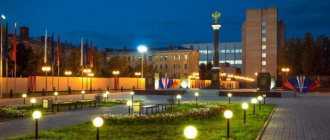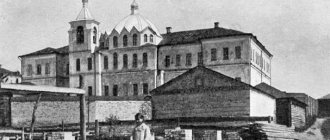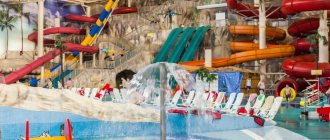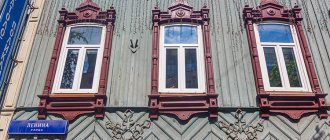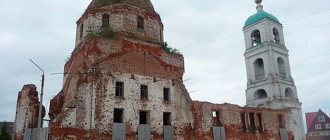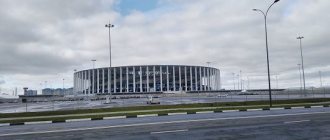The ancient city of Murom is located on the territory of the Vladimir region. The history of its existence is inextricably linked with the centuries-old history of Rus'. The city is located on the left bank of the Oka, which separates the modern Vladimir and Nizhny Novgorod regions. In the historical center of Murom there is a city park, on the edge of which there is a monument to the epic hero Ilya Muromets and an observation deck on the Oka River. Behind the wide riverbed, the opposite bank is clearly visible, gradually receding into the distance of the vast Russian land. As if guarding his native expanses, Ilya Muromets looks beyond the horizon. He raised his sword high, as if warning strangers to protect his native city and all of Rus'. Like many other settlements in our country, Murom is a small city in Russia. As of 2022, its population was just over 100 thousand people. Russian spirituality and legends associated with the centuries-old life of the city are honored here. To get in touch with the history of Rus', you need to walk along these quiet ancient streets of the central part of the city. Visit monasteries and temples, surprising with their incredible architecture, and mentally transport yourself to those turbulent years of the formation of Rus'.
Story
In the 9th century AD the city was the easternmost settlement of the Eastern Slavs in the country of the Finno-Ugric people called Muromtsy. The Primary Chronicle mentions this as early as 862 AD.[13] Thus, it is one of the oldest cities in Russia. Around 900 AD it was an important trading post from Volga Bulgaria to the Baltic Sea.
Between 1010 and 1393 AD it was the capital of a separate principality whose rulers were Saint Gleb, murdered in 1015 and canonized in 1071, Saint Prince Constantine the Blessed, and Saints Peter and Fevronia of Murom, subjects of an opera by Rimsky-Korsakov. It was believed that this is the birthplace of the most famous East Slavic epic hero Ilya Muromets. There is a statue in the city that depicts Elijah holding the hilt of a sword in his left hand and a cross in his right.
On June 30, 1961, Murom became the site of a spontaneous protest and revolt against the police and Soviet authorities after the death in police custody of a senior plant foreman named Kostikov.[14]
Composition of the urban district[ | ]
| № | Locality | Type of settlement | Population |
| 1 | Alexandrovka | village | ↗607[9] |
| 2 | Dmitrievskaya Sloboda | village | ↗1381[9] |
| 3 | Commune | village | 11[9] |
| 4 | Machine operators | village | ↘2227[9] |
| 5 | Moore | city, administrative center | ↘105 572[1] |
| 6 | Muromsky | village | ↘1071[9] |
| 7 | Nezhilovka | village | ↗209[9] |
| 8 | Orlovo | village | ↗781[9] |
| 9 | Factories named after P. L. Voikova | village | ↘1383[9] |
| 10 | Yakimanskaya Sloboda | village | ↗1486[9] |
Attractions
- Three historical abbeys in the city center
- The main temple of the Trinity Convent (1642-1643)
- Painting Ivan Kulikov 1914
- Aerial view of the city in 2014
Murom still retains many traces of antiquity. The Savior Monastery, one of the oldest in Rus', was first mentioned in 1096, when Oleg of Chernigov besieged and killed Vladimir Monomakhtam and buried his son Izyaslav. In 1552, the monastery was visited by Ivan the Terrible who commissioned a stone cathedral, followed by other churches.
Trinity Convent, where the relics of St. Peter and Fevronia, with a beautiful cathedral (1642–1643), Kazan Church (1652), bell tower (1652), wooden church of St. Sergius and stone walls. Competing with it is the Annunciation Monastery, founded during the reign of Ivan the Terrible to house the relics of local princes and the cathedral of 1664. The last two cathedrals mentioned, probably the work of the same masters, have much in common with the Church of the Resurrection (1658) in the city center. A completely different matter is the tented church of St. Cosmas and Damian, built in 1565 on the banks of the Oka in memory of the Russian conquest of Kazan.
MOORE
MURO, a city in Russia, in the southeast. parts of the Vladimir region, the center of the city district of the same name and the Murom municipal district. Us. 107.0 thousand people (2019; 3rd city in the region by number of inhabitants after Vladimir and Kovrov). Located on the left bank of the river. Oka (port), on the border with the Nizhny Novgorod region. A junction of railways and roads (M. is connected to the right bank by railways and cable-stayed road bridges).
Story
First mentioned in The Tale of Bygone Years under 862. Old Russian. the city of M. was founded on the Kremlin Mountain in the 2nd half. 10th century immigrants from the Rostov-Suzdal principality. Within the historical The cultural layer of the city is located Karacharovskaya Upper Paleolithic. parking lot (on the territory of the former village of Karacharovo), an early Iron Age settlement, 2 Murom ground burial grounds (7th–11th, 10th–11th centuries), 3 ancient Russian. settlements (12th–13th centuries). A treasure of 11,077 Kufic dirhams and their scraps (715–939) was found in the Kremlin; The remains of a Muroma sanctuary were also discovered here. Among the finds there are also imported items - jewelry made of stone, glass, and ceramics. Byzantine, Bulgarian and Middle Asian products. origin.
OK. 988 M. transferred to the Kyiv prince. Vladimir Svyatoslavich into the possession of the prince. Gleb Vladimirovich (see in the article Boris and Gleb). In the end 10 – start 11th centuries built wooden c. The All-Merciful Savior, around which the Murom Spaso-Preobrazhensky Monastery was formed. In the 11th century a child was built; to the mountains The territory (length along the bank of the Oka is about 1400 m; the floor border is 700 m from the river) was adjacent to 4 burial mounds. In 1054 it came into possession of the son of the Kyiv prince. Yaroslav Vladimirovich the Wise - Prince of Chernigov. Svyatoslav Yaroslavich, becoming part of the Chernigov principality. In 1088 it was burned by the Bulgars. In 1094–97 M. was under the control of the sons of Vladimir Vsevolodovich Monomakh. At the Lyubech Congress 1097 assigned to the prince. Yaroslav Svyatoslavich. Afterwards they finish. the separation of the Murom-Ryazan princedom from Chernigov (1127) became its capital. All R. 12 – end 14th centuries capital of the Murom principality. The remains of trees have been examined. above-ground log buildings with adobe stoves; the layout of structures into estates and areas of trees was traced. pavements. The white stone Cathedral of the Nativity of the Virgin Mary was probably built in the 12th century. In the winter of 1239/40 M. was burned during the Mongol-Tatar invasion. In 1281 and 1293 Gorodets prince. Andrei Alexandrovich burned the city twice. In the 14th century, the trees were apparently restored. fortifications of the Kremlin (350×120–160 m).
In 1392 he led. book Moscow Vasily I Dmitrievich received from Khan Tokhtamysh a label for the Murom Principality, after which the city officially became part of the Moscow Vel. kn-va. Destroyed during the raid of Edigei in 1408. In the 1420s. The Kremlin was rebuilt and, probably, fortifications of the M. Posad were erected (revealed during excavations). In 1444, Khan Ulug-Muhammad captured M. and spent the winter here. In 1458 the city almost completely burned down. In 1467 it served as a base for Moscow. troops during the 1st Kazan-Rus. war. In 1537 and 1540 it was unsuccessfully besieged by the troops of the Kazan Khan Safa-Girey. In 1552 he served as one of the bases for the Kazan Campaign (see article Kazan Campaigns), after which he lost his military position. meaning. In 1565 it became part of the zemshchina. In the 1570s. gg. Murom faced an epidemic of pestilence and famine, which greatly reduced the city's population. In the 2nd half. 16th century Weapons manufacturing developed, and fish was supplied to the royal court from M. Cultural strata of the Murom Kremlin of the 15th–16th centuries. rich in finds, unlike the cities of the North-East. Rus'.
During the Time of Troubles, the Murom militia was part of the Second Militia of 1611–12. In the end 1615 A. I. Lisovsky’s detachment plundered and partially burned the city. All R. – 2nd floor 17th century The mountains have expanded significantly. territory. In 1654, 1655, 1675 the population of M. suffered from pestilence.
The district town of Kazan (1708–14, 1717–19), Nizhny Novgorod (1714–17), Moscow (1719–78) and Vladimir (1778–1929; until 1796 – Vladimir governorship) provinces. At 18 – beginning. 20th centuries important shopping center. In all likelihood, in the 1740s–60s. The wooden fortifications of the Kremlin were dismantled. From the 2nd half. 19th century The industry developed: the factory of the Murom Linen Manufactory was opened in Dmitrievskaya Sloboda (1880), the Valenkov mechanical and iron foundry (1887), the factory of the Murom Paper Weaving Manufactory (1901), the railway. workshops (1916; now “Muromteplovoz”). The railway was put into operation in 1880. line Murom - Kovrov, in 1912 a bridge was built across the Oka River and railway traffic was opened. line Lyubertsy - Arzamas.
30.10 (12.11).1917 owl was installed. power. On July 8–10, 1918, an unsuccessful action by supporters of the Union for the Defense of the Motherland and Freedom took place in Moscow. District (1929–30), district (since 1929) center of the Nizhny Novgorod (in 1932 renamed Gorky) region (1929–36), Gorky region. (1936–44; now Nizhny Novgorod region) and Vladimir region (since 1944). Since 1939 it has been a city of regional subordination. Since the 1920s developed as an important industry. center of the region. In 1997, a working village was included within the boundaries of Moscow. Verbovsky. Since 2004, the center of the city district of the same name, since 2005 - of the Murom municipal district.
In 2008, the Federation Council of the Russian Federation supported the initiative of the residents of Murom and established the Day of Family, Love and Fidelity on July 8 - the Day of Remembrance of Saints Peter and Fevronia of Murom [June 25, Art. Art.; canonized in 1547; a number of researchers are identified with the Murom prince known from the chronicles. David Yuryevich (d. April 1228) and his wife].
Architecture
Moore. Church of St. Nicholas of the Naberezhny in Merezhnaya Sloboda. 1700–14. Photo by A. I. Nagaev
Until 2nd half. 18th century The city developed along a radial ring system around the Kremlin. In 1788, a regular plan was approved (architect I.M. Lem), according to which straight streets with rectangular blocks built up with low-rise buildings with mezzanines according to “model” designs were laid out. In 1852 the territory of the Kremlin was planned, in 1864 the remaining town rampart was razed, and the floor ditch of the Kremlin was filled in. In the 2nd half. 19th century a general plan for regular development along the main road was created. compositional axis - r. Oka.
Moore. Cathedral of the Holy Annunciation Monastery. 1554–63. Rebuilt in the 1660s. Photo by A. I. Nagaev
In the old part of the city, located on the high, left bank of the Oka, ensembles of monasteries with buildings from the 16th to 19th centuries have been preserved, many with monuments of the elegant Murom pattern of the 17th century: the men's Murom Spaso-Preobrazhensky Monastery and the Holy Annunciation Monastery. on the Old Settlement [1553, closed in 1919, revived in 1991; The 5-domed Annunciation Cathedral on the basement (1554–1563, in the 1660s the top with tiers of kokoshniks was rebuilt, a porch, a southern porch with a 3-tent roof and a bell tower were added; iconostasis - 1797; chapel of the Holy Murom princes Constantine, Michael and Fyodor, buried here), the gate Stefanovskaya Church. (1716, extension – 1835–39)]; women's Holy Trinity Novodevichy [founded in 1642 on the site of a village. temples, successively erected at the end. 12th–16th centuries; closed in 1921, revived in 1991; 5-domed Trinity Cathedral with belts of tiles (1642–43, northern chapel of Saints Prince Peter and Prince Fevronia of Murom, 1996), gateway Kazan Church. (1648–52; hipped bell tower - 1652), rectory building (17th century, rebuilt in 1861), wooden. c. St. Sergius of Radonezh from the village. Pyangus (1715, rebuilt in 1783)] and Holy Resurrection (founded no later than the 16th century, closed in 1764, revived in 2000; 5-domed Resurrection Cathedral with a covered bypass gallery and a hipped porch, 1655–58 or 1646; single-domed Vvedenskaya ts., 1659; hipped bell tower, ca. 1674). Near the coastal cliff are the churches of Saints Cosmas and Damian (tent; between 1556 and 1564, probably by the architect Postnik Yakovlev; the tent collapsed in 1868) and New Kosmodamianskaya (Smolenskaya; 1804, bell tower - 1832, refectory - 1838) in Podokstovye; 5-domed St. Nicholas Embankment in Merezhnaya Sloboda (1700–14; refectory - 1803, expanded in 1847), also the foundations of the Cathedral of the Nativity of the Virgin on Voevodskaya Mountain (1555–57, dismantled in 1939–40) and the Church of St. George the Victorious in Kozhevniki ( 17th century, destroyed in 1936). Of the buildings in the classicist style, the following have been preserved: shopping arcades (1816; in the courtyard there are ruins of the Nikolo-Zaryadskaya Church, 1675–77), shops and storehouses (18–19 centuries) on the square named after. 1100th anniversary of Moscow; numerous residential buildings built after the fires of 1792 and 1805 (merchants Suzdaltsevs, 1826, Karatygins, Nikitins, etc.).
Further from the shore there is a new part of M. with buildings of the 18th–20th centuries: churches - Voznesenskaya (1729), Assumption (1790, bell tower - 1835), Sretenskaya (1795, chapel - 1829, refectory - 1888-1892); water tower (1864), ensemble of zemstvo government buildings [1870; now the Murom Institute (branch) of the Vladimir Technical Institute. university], buildings of a real school (1879), the Murom Linen Manufactory (1880), a religious school (1881–83, architect V.F. Afanasyev), “Lux” cinemas (1911) and "Union" (1913), railway. station in neo-Russian style (1912, architect A.V. Shchusev), residential buildings in the middle. 19 – beginning 20th centuries, including wood. the house of the Gundobins with carvings, the house of the playwright A.K. Gladkov, the house of the merchant V.P. Zvorykin in the spirit of eclecticism (1908). In the 1960s The House of Soviets (1961–68, architect N. A. Bespalov) with a monument to V. I. Lenin in front of it (1962, sculptor Yu. G. Neroda) and the Palace of Culture named after were built. 1100th anniversary of Moscow (1962, architect N.P. Kurennaya). To the south outskirts of the city, in the former With. Karacharovo (mentioned in the 12th century as the birthplace of Ilya Muromets), preserved: the Uvarov estate “Red Mountain” (late 18th - early 19th centuries), Trinity Church. (1811–27), c. Saints Guria, Samon and Aviv (1844–45). In the Verbovsky microdistrict - House of Culture (1961), cemetery church. St. Ilya Muromets (1994–98). In the 2000s. built the chapel of the Archangel Michael (2005–06), Holy Cross Church. (2008–09; on the site of a 12th century monastery of the same name), automobile cable-stayed bridge across the Oka River (2008–2009).
Photo by A.I. Nagaev Murom. Monument to Ilya Muromets. 1999. Sculptor V. M. Klykov.
Among the monuments: N. F. Gastello (1964, sculptor A. O. Bembel, architect N. A. Bespalov), “Epic Stone” (1967, artist S. A. Nikolaev, architect Bespalov), To the Unknown Soldier ( 1970), “Armored train “Ilya Muromets”” (1971, artist Nikolaev, architect Bespalov), aircraft designer R. A. Belyakov (1984, sculptor V. Fetisov, architect Y. Arndt), Ilya Muromets (1999, sculptor V M. Klykov, architect Bespalov), memorial complexes to fellow countrymen-soldiers who died during the Great Ages. Otech. war (1957–85, artist R. A. Kutaev, architect Bespalov, engineer V. Rumyantseva), in memory of those affected by political repression (1996, architect V. A. Shepeta).
Cultural centers
Historical and artistic museum [founded in 1918, modern name since 1997; archaeological collection, icons of the 14th–19th centuries, including a Murom artist of the 18th century. A. I. Kazantseva; face sewing; Western-European painting 14th–19th centuries and Russian painting of the 18th–19th centuries. from the collection of Counts Uvarov; merchant items everyday life; exhibitions - in the house of the merchants Zvorykin (19th century; V.K. Zvorykin was born here) and in the building of the mountains. councils (1815); exhibition hall - in the house of the Golubev merchants; branch – House-museum of art. I. S. Kulikova (1947)].
Farm
The leading industry is mechanical engineering. Factories: “Muromteplovoz” (1916; products for the construction and maintenance of railways, military equipment, including training systems, fire-fighting equipment), switch (1928; transfers, ramps, etc. for railways ), mechanical repair (spare parts and components for railway transport, road construction equipment), radio measuring instruments (1949; as part of the Almaz-Antey East Kazakhstan Concern; radar stations for detecting air targets, aircraft landing systems ), radio plant (1946; equipment for operational communication, warning, broadcasting and signaling), scientific and production enterprise "Zvukotekhnika" (founded in 1953 as a Special Design Bureau; communication complexes), instrument-making (1941; igniter caps, cartridges, electric detonators, measuring devices, initiation means for fire extinguishing systems, pyrotechnic products for military sports games, signaling and rescue equipment, medicines under the VerbaPharm trademark, Muromets (as part of the Azot-Vzryv group of companies); means of initiating charges for blasting mining). Production of pipeline fittings (Murom Pipeline Fittings Plant), plywood (Murom), furniture (Murom-furniture), building materials, shoes (Burevestnik shoe factory), mattresses (Valson, Toris), modified starch (“Dextrin plant”).
Neighborhood
Near M. are located: in the village. Chaadaevo - settlement Chaadaevsky town (8th-11th centuries) - the only known fortified settlement of Murom; in the village Borisogleb - former. Borisoglebsky on Ushna male monastery. (presumably early 12th century, abolished in 1764; Church of the Nativity, mid-17th century); in the village Molotitsy – Uspenskaya Ts. type “octagon on quadruple” (1754); in the village Panfilovo - Voznesenskaya Ts. (1791–1810), artist. gallery (1985; paintings by village natives V.V. Serov, S.I. Chirkov, I.V. Beschastnov and others); in the village Berdishchevo – Krovkov’s estate (1st third of the 19th century); in the village Starye Kotlitsy – c. St. Nicholas (1867–79); in the village Aleshunino - N. A. Nekrasov Museum.
Ethnonym
The name of the city of Murom is mentioned in the Scandinavian sagas of the 13th century as Old Scandinavian. Moramar. Judging by the phonetic patterns of the Volga-Finnish languages, this form recorded a more ancient state of the word than Old Russian. Murom. For the same reasons, the word muroma
most likely is an Old Russian formation from the name of the city.
the oldest form of the ethnonym - * morama
- with the name of the Merya tribe, which, in his opinion, was borrowed from a Baltic source.
According to V.V. Napolskikh, the name of the tribe can be considered as the result of labialization (identified in Murom hydronymy) of the root vowel in the common self-name of the Meri and Mari * mari
, dating back to the Proto-Indoir.
* marya-
“young man, member of the youth military union.”
-ma
part can be a suffix or an analogue of Finnish. maa "earth".
“The Tale of the Establishment of Christianity in Murom” (16th century) offers a folk etymology: “the creation of the city by them, the walls are stone and marble, and therefore is called Murom.” The Encyclopedic Lexicon of Brockhaus and Efron translates the word muroma in Russian as “people on land” without saying exactly which Finnish language this word comes from.
Settlement area3
Murom lived in the territories of modern Ryazan, Vladimir and Nizhny Novgorod regions.
In the north, Murom was bordered by Merya, in the east - by Erzya and Mari, in the south - also by Erzya, in the west - by Meshchera, which was for a long time under its political subordination.
The main part of the archaeological monuments of Murom is located between the left tributaries of the Oka, the Ushna, the Unzha, and the right, the Tesha. In the center of this territory is Murom. It is a small region with dimensions of approximately 30 x 50 km. Beyond its borders there are separate monuments in which elements of the Murom culture are combined with the culture of the surrounding tribes, which allows us to talk about the mixed nature of the population.
Economy and industry of Murom
The basis of Murom's economy is industry, services and trade. The city's industry specializes in mechanical engineering, metal and woodworking, and food production. The most important city-forming enterprise is JSC Murom Instrument-Making Plant (production of initiation means for ammunition). Other large industrial enterprises:
- JSC "Murom Switch Plant";
- JSC "Murom Radio Plant";
- JSC "Murom Mechanical Repair Plant";
- CJSC "Murom Plywood Plant";
- JSC "Murom Bread Factory"
Population of Murom for 2022 and 2022. Number of residents of Murom
Links to official documents and resources on the census are marked with a sign; when you hover your mouse, you will see the name of the document.
| Number of residents of Murom | Years |
| 122,100 people | 2006 |
| 120,800 people | 2007 |
| 119,400 people | 2008 |
| 118,224 people | year 2009 |
| 116,075 people | 2010 |
| 115,865 people | 2011 |
| 114,047 people | year 2012 |
| 112,609 people | year 2013 |
| 111,474 people | year 2014 |
| 110,746 people | 2015 |
| 110,070 people | 2016 |
| 109,809 people | 2017 |
| 109,072 people | 2018 |
Graph of population changes in Murom:
The total population of the city in 2014 was approximately 111.4 thousand people, and the density was 2546.23 people/km².
In the period from 1959 to 1992, the number of Murom residents doubled. In the 60s, a phenomenon such as a decrease in the birth rate arose in the USSR, and therefore the population of the city increased mainly due to the relocation of rural residents. In the late 80s and 90s, the difficult economic situation contributed to a decline in the birth rate and a simultaneous increase in mortality.
The specific figures are as follows: in 1999, the number of births was 6.4/1000, deaths – 14.3/1000, natural decline – 8.4/1000. In 2001 – 7.2/1000, 15.6/1000 and 8.4/1000, respectively. In 2003 – 8.2/1000, 18.1/1000 and 9.9/1000. In 2005 – 8.3/1000, 18.8/1000 and 10.5/1000. In 2006 – 8.7/1000, 17.8/1000 and 9.1/1000. In 2007 – 8.7/1000, 17/1000 and 8.3/1000.
An additional stimulus for population decline was given by plans to build a Nizhny Novgorod nuclear power plant 23 kilometers from the city. Young families with children were afraid of this neighborhood and said that they might leave Murom.
95% of Murom residents are Russian. The remaining 5% are Belarusians, Jews, Mordovians, Poles, Tatars, Ukrainians, Czechs and other nationalities. Ethnic burial: Muromlyanin, Muromets, Muromchanin, Muromlyanka, Muromchanka, Muromlyans, Muromtsy, Muromchane.
Murom City Day 2016 HOLIDAY PROGRAM
Summer continues and promises us many more interesting and bright weekends! This coming Saturday we are happy to invite you to Murom, which will celebrate its 1154th birthday this year!
City Day, scheduled for August 6, will consist of three blocks. The first block - the daytime part - includes many interactive platforms. All of them are united by a common motto: “Spend City Day with benefit.”
— We want people to be able to come to the center of Murom with their children and friends on this day and at the same time relax, have fun, and learn something useful,
— said the head of the Murom district, Evgeny Rychkov, on his website.
“ For this purpose, a whole range of diverse master classes will be organized: sports, culinary, creative - everything that will not only be interesting, but will also help you acquire any skills in literally 15-20 minutes.
Here you can take pictures in specially equipped photo zones, just take a walk or go to the crafts fair, of which there will be several hundred this year. The second block is the international stage of the All-Army Competition of Engineering Troops “Open Water”. The event will take place in Karacharovo - the homeland of Ilya Muromets. The third block will be the evening part of the celebration on the Oka embankment. By the way, a big concert traditionally takes place here on the Day of Family, Love and Fidelity.
— Will there be fireworks?
- you ask.
It will be, and what kind of one! This year we decided to hold a fireworks competition. By the way, it will be held in Murom for the first time.
— It is expected that four teams will participate in it and compete among themselves for the main prize,
— said Evgeny Rychkov.
— Each team prepares its own program with musical accompaniment, and Murom residents will then cast their votes in support of those contestants they like best.
Voting will be organized on my website on the Internet. I hope this will become another Murom tradition and will make our embankment a place for large cultural events. There are few embankments like this, and we want it to become one of the brands of our city. Program of events for Murom City Day
By the way, did you know that 14 years ago Murom got its own anthem? Yes Yes! The lyrics were written by Andrey Melgunov, the music by Alexander Demin.
Anthem of the city of Murom
Our city is for the good of the Fatherland, It has daring and wise peace. Glorious for his work and courage, Beautiful with a broad soul.
Murom, and to this day the centuries have no power over you. Murom-grad is a shrine, Our faith in you is great!
Our land has many years to come! The seed of victory sprouted in her. The city, glorified in epics, raised Rus' to its wings.
Murom, and to this day the centuries have no power over you. Murom-grad is a shrine, Our faith in you is great!
What else is interesting?
We know 15 more reasons to come to Murom! Do you want to know too? That way.
Photo on the main page - book33.ru
Founding of Murom
Murom is one of the oldest Russian cities. In the Tale of Bygone Years, mention of him dates back to 862. The Finno-Ugric tribe Murom, related to the Mordovians, made up the majority of its population. The location of Murom on the trade route between Russia and Volga Bulgaria contributed to the development of the city and trade; it was precisely because of its advantageous location that Murom survived many wars and raids, was burned several times, fell into disrepair and was revived again. Murom has long been a border town - an eastern outpost of Ancient Rus'. The cult of pagan gods flourished in Murom, and the influence of the priests was great.
The Kiev prince Vladimir gave Murom to his son Gleb as an inheritance. Prince Gleb Vladimirovich, later canonized, tried to convert its population to Christianity, but failed and was forced to flee discontent in a fortified courtyard.
Since 1054, Murom became the possession of the Chernigov princes, who already in 1097 turned it into the capital of the Murom-Ryazan principality.
In 1127, under Prince Yaroslav Svyatoslavich, the Murom-Ryazan land was separated from the Chernigov principality into an independent one. It is Prince Yaroslav and his family that historians and church tradition identify with the saints Prince Konstantin, Princess Irina and their sons Prince Mikhail and Prince Theodore who baptized the Murom land, who were killed by Murom pagans.
In 1129, after the death of Prince Yaroslav Svyatoslavich, his son Yuri (Theodore) Yaroslavich sat on the Murom table, then his third son Svyatoslav reigned for two years, and later his grandson Rostislav.
Slavic colonization
In the processes of Slavic colonization of the region, Murom played an important role as a fortified point for the establishment of princely power. Slavic dominance on the lower Oka was consolidated by the campaign of Svyatoslav on the Oka and Volga in 965 and Vladimir Svyatoslavovich in 985. In 988, the first prince Gleb Vladimirovich appeared in Murom. According to archaeological data, the central fortified manor of the city was built in the second half of the 10th century on a previously uninhabited site, located in the center between Murom and possibly Slavic villages. Prince Gleb, to whom the city of Murom was assigned as an inheritance, made a lot of efforts to take possession of it and persuade its inhabitants to accept Christianity, but could not do this and lived for two years away from it at a distance of two fields (12 versts) on the Ishna River. After Saint Gleb was killed, Murom remained for a long time without a Christian prince, and paganism remained in force there. Meanwhile, the neighbors, the Muslim Volga Bulgarians, tried to spread their influence and faith to Murom.
The well-known Ilya Muromets is considered one of the epic heroes of the ancient Russian epic.
In the second half of the 10th and 11th centuries, the influence of Slavic culture, in particular ceramics, begins to show itself in the materials of the Tumovsky village and burial grounds. There are known cases of the paired existence of Murom and Slavic villages. Judging by the available Slavic objects, the Krivichi originally settled on the land of the Muroms.
Vyatichi and Murom quickly mixed and settled in the region in stripes. Murom and other large localities were inhabited by both Vyatichi and Murom. The close rapprochement was greatly facilitated by the fact that both tribes were ossified in paganism; in terms of culture, the Murom stood, perhaps, above the Vyatichi,
The Muroma culture is gradually degrading and losing its originality. Women's head decorations are disappearing. In the first half of the 11th century, the originality of Murom objects disappears, although some typically Murom objects still remain. One of the signs of Slavic influence was the change in the position of the dead with their heads to the west, instead of the previous ones with their heads to the north.
Items of Murom weapons - spear and arrowheads, battle axes - reached the best European standards in terms of workmanship and combat characteristics. This indicates that the version of Soviet historians about the peaceful assimilation of Murom by the Slavs is, at a minimum, implausible. In fact, it was either a military confrontation or contractual terms of suzerainty with Kiev, followed by Chernigov and Vladimir-Mersky, the integration of Murom and the Murom people into the political system of Eastern Europe. The second option seems more convincing.
By the 12th century, the Muroma were no longer mentioned in chronicles as a separate people - by this time Kyiv and Chernigov preferred to deal with a “geographical region” rather than a people who had well mastered the Slavic speech as a lingua franca.
In 1192, approaching Murom, Prince Konstantin sent his son Mikhail to convince the Murom people to accept the prince without resistance. The stubborn pagans killed the sent prince and threw his body outside the city, while they themselves began to prepare for battle. When Prince Constantine approached the city with his large retinue, the inhabitants wanted to fight, then they resigned themselves, agreed to accept the prince, but did not want to replace their paganism with his faith.


